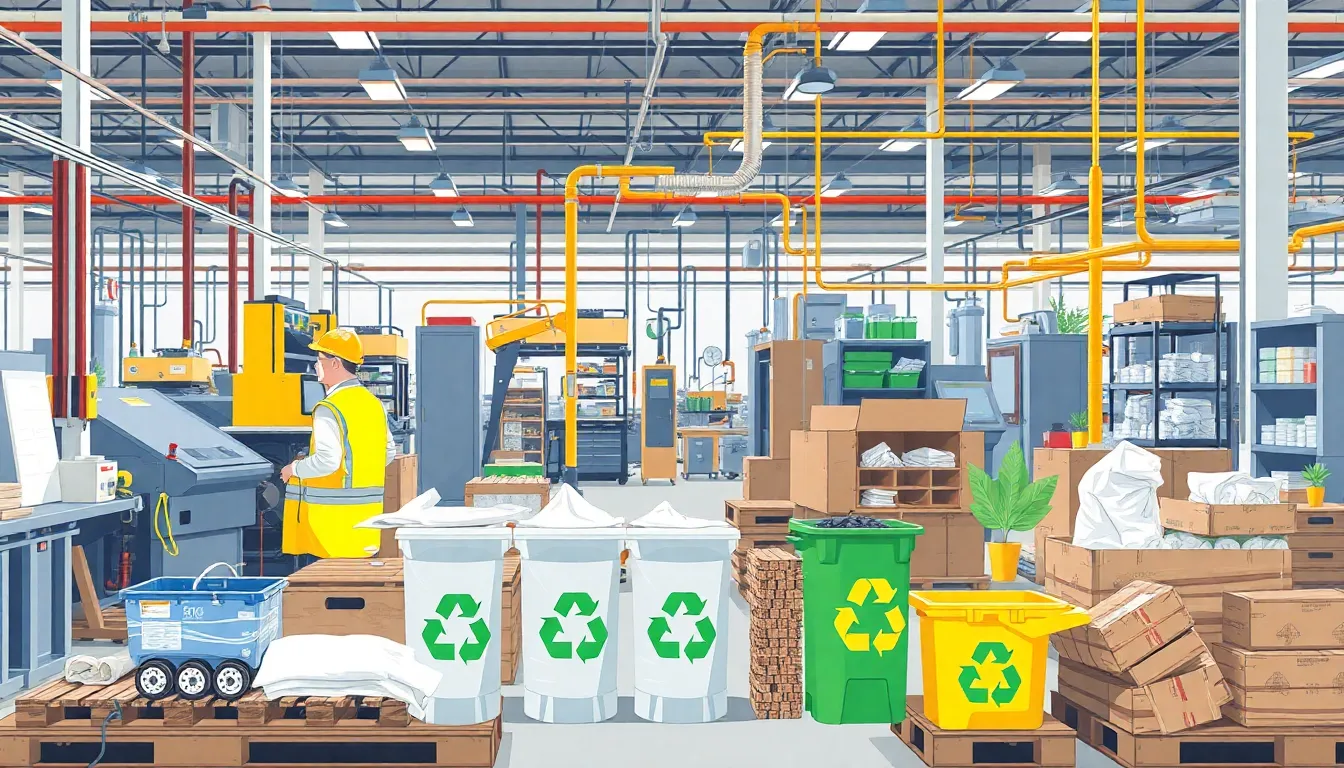In a world where “waste not, want not” has never been more relevant, circular economy principles are stepping into the spotlight like a superhero at a comic book convention. Instead of the old linear model of “take, make, dispose,” this innovative approach flips the script, turning trash into treasure. Imagine a system where products are designed to last, be reused, and recycled—it’s like a never-ending party for materials!
Table of Contents
ToggleOverview of Circular Economy Principles
Circular economy principles focus on creating a regenerative system that minimizes waste and maximizes resource efficiency. The first principle, designing for longevity, emphasizes creating products that last, rather than those intended for single use. Companies prioritize materials that can be easily repaired or updated, extending the life cycle of their offerings.
Reuse stands as a core tenet of this approach. Transitioning to systems that promote multiple uses of products helps reduce the overall demand for new resources. For example, many businesses encourage customers to return old items for refurbishment or resale, contributing to a more sustainable ecosystem.
Recycling also plays a critical role in the circular economy. By turning waste into new raw materials, recycling minimizes the extraction of fresh resources. Advanced recycling technologies enable previously unrecyclable materials to enter the production cycle, further supporting sustainability goals.
Collaboration represents another essential principle. Stakeholders, including manufacturers, retailers, and consumers, work together to create closed-loop systems. This collaboration fosters innovation and drives systemic change within industries, ensuring that every material remains part of a productive cycle.
Lastly, systems thinking is vital. Embracing interconnected relationships between materials, products, and systems allows for a holistic understanding of impacts and benefits. By grasping these relationships, companies can identify new opportunities to enhance sustainability practices and drive economic growth in a circular manner.
Key Components of Circular Economy

The key components of a circular economy focus on sustainability and efficiency. Understanding these elements is essential for transitioning to a more sustainable system.
Resource Efficiency
Resource efficiency involves using materials in the most effective way possible. This approach minimizes inputs while maximizing outputs. Companies aim to utilize fewer resources in production processes while delivering high-quality products. Adopting renewable resources contributes to this efficiency. Manufacturers also adopt innovative technologies to enhance resource utilization. Implementing processes that reduce energy consumption plays a vital role as well. Optimizing logistics and supply chains reduces waste throughout production cycles. Strategies that promote a circular flow of resources support long-term sustainability.
Waste Minimization
Waste minimization focuses on reducing the amount of waste generated throughout various processes. Efficient product design encourages durability, significantly decreasing the likelihood of disposal. Implementing take-back schemes allows companies to reclaim and repurpose products at the end of their lifecycle. Consumers actively participating in recycling initiatives also contributes to this goal. Organizations promote methods that allow for the reuse of materials, thereby extending their lifecycle. Efforts to educate all stakeholders about waste reduction foster a culture of sustainability. Minimizing waste ultimately leads to lower environmental impact and conserves valuable resources.
Benefits of Implementing Circular Economy Principles
Implementing circular economy principles offers significant advantages for both the environment and the economy.
Environmental Impact
Environmental preservation becomes a primary focus through circular economy practices. Resource conservation is evident as companies reduce the extraction of raw materials. Waste reduction leads to fewer landfills and decreased pollution levels, enhancing air and water quality. Additionally, using recycled materials minimizes energy consumption compared to conventional production methods. Biodiversity gains protection as ecosystems suffer less disruption from resource extraction. By prioritizing sustainability, companies contribute positively to climate change mitigation efforts.
Economic Advantages
Economic benefits emerge when businesses adopt circular economy principles. Cost savings manifest through reduced resource inputs and improved operational efficiency. Revenue streams can diversify as companies explore innovative business models, such as product-as-a-service. Job creation occurs within recycling and refurbishment industries, leading to economic growth. Furthermore, enhanced competitiveness arises as organizations attract environmentally conscious consumers. Stronger collaboration among stakeholders drives systemic innovation, promoting overall economic resilience. Implementing these principles fosters a vibrant, sustainable economy that balances profitability with environmental stewardship.
Challenges in Adopting Circular Economy
Implementing circular economy principles faces a variety of significant challenges that can hinder progress towards sustainability. These challenges include industry resistance and policy and regulation barriers.
Industry Resistance
Industry resistance poses a major hurdle in the adoption of circular economy principles. Many companies remain entrenched in traditional, linear manufacturing processes due to established practices and investment in existing technologies. Fear of higher costs often deters firms from shifting to circular models. Some organizations lack awareness about the long-term benefits of transitioning toward a circular system. Additionally, skepticism regarding market demand for reused or recycled products limits their willingness to innovate. The need for collaboration across sectors is pressing; however, various stakeholders encounter difficulties when attempting to align their interests and practices, making unified action a challenge.
Policy and Regulation Barriers
Policy and regulation barriers inhibit the advancement of circular economy frameworks. Existing regulations often favor linear models, creating disincentives for businesses attempting to adopt circular practices. For instance, subsidies for fossil fuels and resource extraction discourage sustainable alternatives. Furthermore, inconsistent policies across regions complicate compliance for companies operating internationally. Unclear guidelines on waste management and recycling create confusion among stakeholders. Regulatory frameworks that promote innovation and investment in circular solutions are necessary to encourage substantial change. Without supportive policies, achieving widespread circular economy adoption remains difficult for companies striving for sustainability.
Case Studies in Circular Economy
Numerous companies illustrate the successful implementation of circular economy principles. Interface, a global carpet tile manufacturer, has embraced sustainability by using recycled materials for its products. They reduced their greenhouse gas emissions by 96% since 1996 and aim to achieve a carbon negative footprint by 2040.
Similarly, Patagonia, an outdoor apparel brand, demonstrates circularity through its Worn Wear program. This initiative promotes repairing, reusing, and recycling clothing, extending product life and encouraging responsible consumption. Customers appreciate the opportunity to trade in used items, allowing Patagonia to refurbish and resell them.
Ecovative represents another innovative example, producing plant-based alternatives to Styrofoam for packaging. By using agricultural waste, they reduce landfill waste and provide a sustainable substitute for harmful materials. This approach highlights how material innovation can foster both environmental and economic growth.
In the tech industry, Apple incorporates circular principles through its recycling programs. Their partnership with various organizations helps recover valuable materials from old devices, reducing the need for new resource extraction. Apple claims to have achieved over 100% recycled aluminum in some products, showcasing their commitment to sustainability.
Unilever has also committed to circularity by emphasizing sustainable packaging. They aim to make all of their plastic packaging recyclable, reusable, or compostable by 2025. Their proactive measures show a dedication to minimizing plastic waste and promoting responsible production.
These case studies underscore the tangible benefits of adopting circular economy practices. Enhanced resource efficiency and waste reduction often lead to increased cost savings and consumer loyalty. By prioritizing circularity, these organizations not only contribute to environmental stewardship but also set a benchmark for others in their respective industries.
Embracing circular economy principles is essential for fostering a sustainable future. By prioritizing resource efficiency and waste reduction, businesses can not only minimize their environmental impact but also unlock new economic opportunities. The shift from a linear to a circular model encourages innovation and collaboration among stakeholders, paving the way for a more resilient economy.
As companies like Interface and Patagonia demonstrate, implementing these principles leads to significant benefits, including cost savings and enhanced brand loyalty. The path to a circular economy may present challenges, but with supportive policies and a commitment to sustainability, organizations can thrive while contributing to a healthier planet. Adopting these practices isn’t just an option; it’s a necessity for a sustainable and prosperous future.



